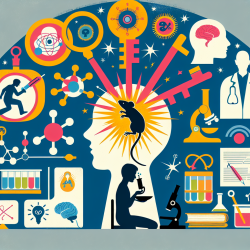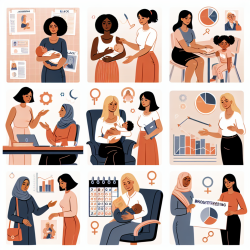Introduction
In the realm of speech-language pathology, understanding the nuances of mental health and its impact on communication is crucial. A recent scoping review, "A scoping review of research literature on eating and body image for transgender and nonbinary youth," sheds light on the often-overlooked intersection of gender identity, eating disorders, and body image among transgender and nonbinary (TGNB) youth. This review provides valuable insights that can enhance practitioners' skills and encourage further research to improve outcomes for this vulnerable population.
Key Findings from the Review
The review analyzed 49 studies focusing on TGNB adolescents and young adults, revealing a higher prevalence of eating disorders and body image issues compared to their cisgender peers. Notably, body-gender congruence achieved through gender-affirming interventions such as hormone therapy significantly alleviated body image problems and facilitated eating disorder treatment.
However, the review also highlighted gaps in the literature, particularly the lack of understanding of family and social factors influencing TGNB youth. This underscores the need for more research on TGNB youth from diverse racial, ethnic, and neurodiverse backgrounds.
Implementing Research Outcomes in Practice
Practitioners can enhance their skills by integrating the findings of this review into their practice. Here are some actionable steps:
- Embrace Gender-Affirming Practices: Incorporate gender-affirming interventions, such as using preferred names and pronouns, into therapy sessions to foster a supportive environment.
- Understand the Role of Body-Gender Congruence: Recognize the importance of body-gender congruence in alleviating body image issues and work collaboratively with medical professionals to support hormone therapy and other interventions.
- Consider Family and Social Contexts: Engage with families and social networks to address external stressors and promote acceptance and support for TGNB youth.
- Promote Inclusive Research: Encourage research that includes diverse TGNB youth populations to better understand the unique challenges faced by different subgroups.
Encouraging Further Research
While the review provides a comprehensive overview of the current literature, it also highlights areas where further research is needed. Practitioners and researchers are encouraged to explore the following:
- Longitudinal Studies: Conduct longitudinal studies to understand the long-term effects of gender-affirming interventions on eating disorders and body image.
- Intersectionality: Investigate the intersectionality of race, ethnicity, and neurodiversity in TGNB youth to develop tailored interventions.
- Family Dynamics: Study the impact of family dynamics and support on the mental health and well-being of TGNB youth.
Conclusion
By implementing the outcomes of this research and encouraging further studies, practitioners can play a pivotal role in improving the lives of TGNB youth. Understanding the complex interplay of gender identity, eating disorders, and body image is essential for creating effective, inclusive, and supportive therapeutic environments.
To read the original research paper, please follow this link: A scoping review of research literature on eating and body image for transgender and nonbinary youth.










